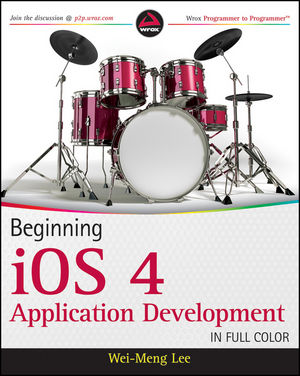Beginning iOS 4 Application DevelopmentISBN: 978-0-470-91802-9
Paperback
656 pages
October 2010
 This title is out-of-print and not currently available for purchase from this site.
|
Introduction xvii
Part I: Getting Started
Chapter 1: Getting Started with iOS 4 Programming 3
Obtaining the iPhone SDK 4
Components of the iPhone SDK 6
Some Useful Information before You Get Started 17
Summary 20
Chapter 2: Write Your First Hello World! Application 23
Getting Started with Xcode 23
Customizing Your Application Icon 34
Displaying a Splash Screen 36
Summary 39
Chapter 3: Views, Outlets, and Actions 41
Outlets and Actions 41
Using Views 47
Adding Views Dynamically Using Code 64
Understanding View Hierarchy 68
Summary 70
Chapter 4: View Controllers 73
The View-Based Application Template 74
The Window-Based Application Template 85
The Split View-Based Application Template 103
The Tab Bar Application Template 122
Summary 131
Chapter 5: Multi-Platform Support for the iPhone and iPad 133
Technique 1 — Modifying the Device Target Setting 134
Technique 2 — Creating Universal Applications 141
Technique 3 — Maintaining Two Code Bases 149
Making Your Choice 151
Summary 152
Chapter 6: Keyboard Inputs 155
Using the Keyboard 155
Customizing the Type of Inputs 157
Detecting the Presence of the Keyboard 165
Summary 178
Chapter 7: Screen Rotations 181
Responding to Device Rotations 181
Programmatically Rotating the Screen 190
Summary 192
Part II : Displaying and Persisting Data
Chapter 8: Using the Table View 197
A Simple Table View 198
Using the Table View in a Navigation-Based Application 210
Displaying Sections 210
Summary 239
Chapter 9: Application Preferences 241
Creating Application Preferences 242
Programmatically Accessing the Settings Values 248
Summary 257
Chapter 10: File Handling 261
Understanding the Application Folders 262
Using Property Lists 267
Copying Bundled Resources 274
Summary 275
Chapter 11: Database Storage Using SQLite3 279
Using SQLite3 280
Creating and Opening a Database 282
Bundling SQLite Databases with Your Application 291
Summary 292
Part III : Advanced iOS 4 Programming Techniques
Chapter 12: Simple Animations and Video Playback 297
Using the NSTimer Class 297
Transforming Views 305
Animating a Series of Images 310
Playing Video on the iPhone 313
Summary 317
Chapter 13: Accessing Built-In Applications 319
Sending E‑Mails 319
Accessing the Camera and the Photo Library 328
Summary 341
Chapter 14: Recognizing Gestures 343
Recognizing Gestures 343
Detecting Touches 367
Summary 383
Chapter 15: Accessing the Accelerometer 385
Using the Accelerometer 385
Visualizing the Accelerometer Data 388
Using the Shake API to Detect Shakes 392
Summary 399
Part IV: Network Programming Techniques
Chapter 16: Web Services 403
Basics of Consuming XML Web Services 403
Consuming a Web Service in Your iPhone Application 407
Parsing the XML Response 413
Summary 418
Chapter 17: Bluetooth Programming 421
Using the Game Kit Framework 421
Implementing Voice Chatting 431
Summary 438
Chapter 18: Bonjour Programming 441
Creating the Application 441
Publishing a Service 443
Browsing for Services 446
Summary 452
Chapter 19: Apple Push Notification Service 455
Generating a Certificate Request 456
Generating a Development Certificate 457
Creating an Application ID 461
Creating the iPhone Application 467
Creating the Push Notification Provider 471
Summary 475
Chapter 20: Displaying Maps 477
Displaying Maps and Monitoring Changes Using the Map Kit 477
Getting Location Data 483
Summary 515
Chapter 21: Background Applications 519
Understanding Background Execution on the iPhone 519
Local Notification 530
Summary 537
Part V: Appendices
Appendix A: Testing on an Actual Device 541
Signing Up for the iPhone Developer Program 541
Obtaining the UDID of Your Device 541
Logging in to the iPhone Provisioning Portal 542
Generating a Certificate 544
Registering Your Devices 547
Creating an Application ID 548
Creating a Provisioning Profile 550
Understanding Application ID and the Wildcard 554
Preparing for App Store Submission 557
Summary 563
Appendix B: Getting Around in Xcode 565
Launching Xcode 565
Debugging Your Applications 571
Appendix C: Getting Around in Interface Builder 577
.xib Window 577
Designing the View 578
Inspector Window 579
Library 581
Outlets and Actions 582
Appendix D: Crash Course in Objective-C 591
Directives 591
Classes 592
Memory Management 605
Protocols 612
Selectors 615
Categories 616
Appendix E: Answers to Exercises Wrox.com
Index 619



